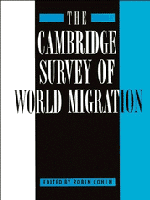Book contents
- Frontmatter
- Contents
- List of illustrations
- List of tables
- Notes on the contributors
- 1 Prologue
- 2 European colonization and settlement
- 3 Asian indentured and colonial migration
- 4 The great Atlantic migration to North America
- 5 Migration in Europe, 1800–1950
- 6 Migration in Africa
- 7 Latin and Central American migration
- 8 Migration to North America after 1945
- 9 Labour migration to western Europe after 1945
- 10 Repatriates and colonial auxiliaries
- 11 Migration in Asia and Oceania
- 12 Migration in the Middle East
- 13 Refugees from political conflict
- 14 Migrants and asylum-seekers in contemporary Europe
- 15 Emerging trends
- Acknowledgements and credits
- Index
4 - The great Atlantic migration to North America
Published online by Cambridge University Press: 05 December 2012
- Frontmatter
- Contents
- List of illustrations
- List of tables
- Notes on the contributors
- 1 Prologue
- 2 European colonization and settlement
- 3 Asian indentured and colonial migration
- 4 The great Atlantic migration to North America
- 5 Migration in Europe, 1800–1950
- 6 Migration in Africa
- 7 Latin and Central American migration
- 8 Migration to North America after 1945
- 9 Labour migration to western Europe after 1945
- 10 Repatriates and colonial auxiliaries
- 11 Migration in Asia and Oceania
- 12 Migration in the Middle East
- 13 Refugees from political conflict
- 14 Migrants and asylum-seekers in contemporary Europe
- 15 Emerging trends
- Acknowledgements and credits
- Index
Summary
The Atlantic crossing by European migrants to the Americas is the stuff of legend. Hundreds of tons of wood pulp and thousands of miles of cinematographic film have been used to dramatize or record the reminiscences of those who made the crossing. Many of the immigrants – some 12 million people – were landed at Ellis Island in New York Harbour for immigration inspection. There they could see, in full sight, the nearby Statue of Liberty with its inspiring inscription by Emma Lazarus welcoming those of the world's ‘huddled masses’, who were ‘yearning to be free’. With the Boston Tea Party, Lincoln's Gettysburg address and Washington's battles at Valley Forge, the immigrants' arrival into New York has become part of the founding mythology of the USA. The expressions ‘The Land of the Free’, ‘The Golden Door’ and ‘From Rags to Riches’ all stem from this powerful experience.
Like all myths there is an element of truth to these sentiments: the New World and the USA in particular did provide a great chance for those escaping the miserable conditions of nineteenth century Europe. However, we need to puncture the myth somewhat to gain some sense of its limits. Many destitute and sick people were turned back at Ellis Island as immigration legislation and practice became more selective. And, because the shipping companies had to pay for the costs of the return journey, they were increasingly reluctant to allow anyone to board in Europe who looked as if they might be rejected.
- Type
- Chapter
- Information
- The Cambridge Survey of World Migration , pp. 77 - 122Publisher: Cambridge University PressPrint publication year: 1995



